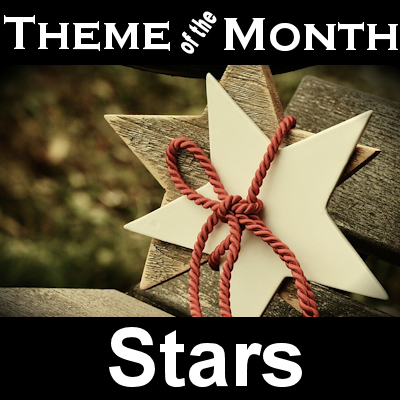Home of the Scrapbook Campus › Forums › Lobby › Chit Chat › Alphabet Game – STARS
Tagged: Celestial Elements
- This topic has 60 replies, 11 voices, and was last updated 5 years, 2 months ago by
libera.
-
AuthorPosts
-
April 2, 2019 at 7:09 pm #27471

In April, our monthly theme is STARS.
Let’s play our monthly alphabet game.
Based on the alphabet, name a star, a constellation or another celestial element. I am sure you will be needing some help from Google. Why not? Maybe we’ll learn some things? If you have a reference or an image to illustrate, go for it?
Let’s go!
(remember: only ONE answer per letter, to give us more options for seconds if we get to that point)
April 2, 2019 at 7:51 pm #27473A – Asteroids
April 2, 2019 at 8:13 pm #27474B = Betelgeuse
April 2, 2019 at 9:09 pm #27477C = Capricorn
April 3, 2019 at 10:31 am #27484D = Dark Hole
April 4, 2019 at 4:38 pm #27498E = Earth
April 7, 2019 at 8:03 am #27529F = Fusion (nuclear fusion) “supports the star’s enormous mass from collapsing in on itself and heats the star so high that it glows and is so bright that we can see it.”
April 7, 2019 at 8:05 am #27530G = Galaxy (system of about 100 billion stars)
April 7, 2019 at 1:51 pm #27543Orion’s Belt or the Belt of Orion, also known as the Three Kings or Three Sisters, is an asterism in the constellation Orion. It consists of the three bright stars Alnitak, Alnilam and Mintaka. Looking for Orion’s Belt in the night sky is the easiest way to locate Orion in the sky. Wikipedia
April 7, 2019 at 1:58 pm #27545Dave, do you have something for the next letter, which was H?
April 8, 2019 at 7:55 am #27576H = Halo (circle of light appearing to surround the sun or moon and resulting from refraction or reflection of light by ice particles in the atmosphere from = Merriam-Webster dictionary definition) I discovered a halo for the first time in January and February and tried to know what it was.
April 8, 2019 at 7:36 pm #27586I = Ionosphere
April 8, 2019 at 9:31 pm #27587J = Jupiter
April 10, 2019 at 1:27 pm #27607K = Kitalpha
April 10, 2019 at 3:25 pm #27609L = lunar
April 10, 2019 at 11:26 pm #27610M= Moon so full and bright.
April 11, 2019 at 6:20 am #27611N = Neptune
April 12, 2019 at 4:06 am #27612O = Orion
April 12, 2019 at 10:13 am #27615P = Polaris
April 12, 2019 at 3:02 pm #27616Q=Quarter moon
April 13, 2019 at 8:45 am #27619R= Ring galaxy
April 13, 2019 at 8:47 am #27620S=Supergiant
April 13, 2019 at 9:53 pm #27686T = telescope
April 13, 2019 at 9:58 pm #27687U = Uranus
April 13, 2019 at 10:14 pm #27689V – Venus (although it is not a star either, it is still in the sky and might look like a star with the naked eye)
April 14, 2019 at 7:03 am #27700W = Wormhole (Do theoretic celestial bodies count?
April 14, 2019 at 7:36 am #27701X = X-ray
April 14, 2019 at 9:10 pm #27730Y= Yellow Dwarf (It f is a star and is often referred to as a G-type main sequence star. A perfect example of a yellow dwarf would be the sun. A yellow dwarf has a mass almost like the mass of the sun. Its color ranges from white to a lighter yellow).
April 15, 2019 at 4:53 pm #27807Z = zenith
April 19, 2019 at 9:05 am #27921Anyone want to go again…who has an A?
-
AuthorPosts
- You must be logged in to reply to this topic.







